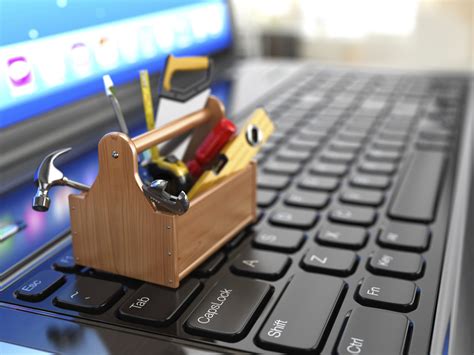As technology continues to advance and play a larger role in our daily lives, having the right tools at your disposal is crucial for tackling various tasks and projects. Whether you're a tech enthusiast, a DIY expert, or a professional in the industry, having a well-stocked tech toolbox can make all the difference. In this article, we'll explore seven essential tools that every tech enthusiast should have in their arsenal.
1. Multimeter

A multimeter is a versatile tool that allows you to measure voltage, current, and resistance in electrical circuits. It's an essential tool for diagnosing and troubleshooting electrical issues, and is a must-have for any tech enthusiast. With a multimeter, you can quickly identify problems and make adjustments to get your projects up and running.
How to Use a Multimeter
Using a multimeter is relatively straightforward. Simply select the function you want to measure (voltage, current, or resistance), and connect the leads to the circuit or component you want to test. The multimeter will display the measurement on its screen, allowing you to diagnose and troubleshoot issues.
2. Wire Strippers

Wire strippers are a simple but essential tool for any tech enthusiast. They allow you to remove the insulation from electrical wires, exposing the conductive core underneath. This is useful for a variety of tasks, from repairing electrical connections to building custom cables.
How to Use Wire Strippers
Using wire strippers is easy. Simply place the wire in the stripping jaws, and squeeze the handles together. The insulation will be removed, leaving the conductive core exposed. Be careful not to damage the wire or strip too much insulation, as this can compromise the integrity of the connection.
3. Soldering Iron

A soldering iron is a crucial tool for any tech enthusiast who works with electrical components. It allows you to join components together by melting solder, creating a strong and reliable connection. With a soldering iron, you can build custom circuits, repair damaged connections, and even create your own electronics projects.
How to Use a Soldering Iron
Using a soldering iron requires some practice and patience. Start by heating the iron to the correct temperature, and then apply solder to the components you want to join. Use the iron to melt the solder, creating a strong bond between the components.
4. Pliers and Punchdown Tool

Pliers and a punchdown tool are essential for any tech enthusiast who works with electrical wires. The pliers allow you to bend and shape the wires, while the punchdown tool helps you secure them in place. With these tools, you can create custom wire configurations, repair damaged connections, and even build your own electronics projects.
How to Use Pliers and a Punchdown Tool
Using pliers and a punchdown tool is relatively straightforward. Simply use the pliers to bend and shape the wires, and then use the punchdown tool to secure them in place. Be careful not to damage the wires or surrounding components.
5. Cable Tester

A cable tester is a handy tool for diagnosing issues with electrical cables. It allows you to test the continuity and integrity of the cable, identifying any faults or damage. With a cable tester, you can quickly identify problems and make repairs, saving you time and hassle.
How to Use a Cable Tester
Using a cable tester is easy. Simply connect the tester to the cable, and press the test button. The tester will indicate whether the cable is functioning correctly, or if there are any faults or damage.
6. Thermal Camera

A thermal camera is a specialized tool that allows you to detect temperature anomalies in electrical systems. It's a valuable tool for diagnosing issues with overheating components, and can help you identify potential problems before they become major issues.
How to Use a Thermal Camera
Using a thermal camera is relatively straightforward. Simply point the camera at the electrical system or component you want to test, and take a reading. The camera will display the temperature of the system or component, allowing you to identify any anomalies or issues.
7. Oscilloscope

An oscilloscope is a powerful tool for visualizing electrical signals and waveforms. It allows you to see the shape and amplitude of the signal, making it easier to diagnose issues and troubleshoot problems. With an oscilloscope, you can gain a deeper understanding of the electrical systems you're working with.
How to Use an Oscilloscope
Using an oscilloscope requires some practice and patience. Start by connecting the oscilloscope to the electrical system or component you want to test, and then adjust the settings to optimize the display. Use the oscilloscope to visualize the signal, and take note of any anomalies or issues.





We hope this article has provided you with a comprehensive guide to the essential tools every tech enthusiast should have in their toolbox. Whether you're a seasoned pro or just starting out, these tools will help you tackle a wide range of tasks and projects with confidence.
What are the most essential tools for a tech enthusiast?
+The most essential tools for a tech enthusiast include a multimeter, wire strippers, soldering iron, pliers and punchdown tool, cable tester, thermal camera, and oscilloscope.
How do I choose the right tools for my tech projects?
+When choosing tools for your tech projects, consider the specific tasks and requirements of the project. Choose tools that are durable, reliable, and easy to use. Additionally, consider the cost and value of the tools, as well as any safety features or certifications.
What are some common mistakes to avoid when using tech tools?
+Common mistakes to avoid when using tech tools include using the wrong tool for the job, not following safety protocols, and not properly maintaining or storing the tools. Additionally, be careful not to damage the tools or surrounding components, and always follow the manufacturer's instructions.
We hope you found this article informative and helpful. If you have any questions or comments, please don't hesitate to reach out. Happy building and tinkering!
